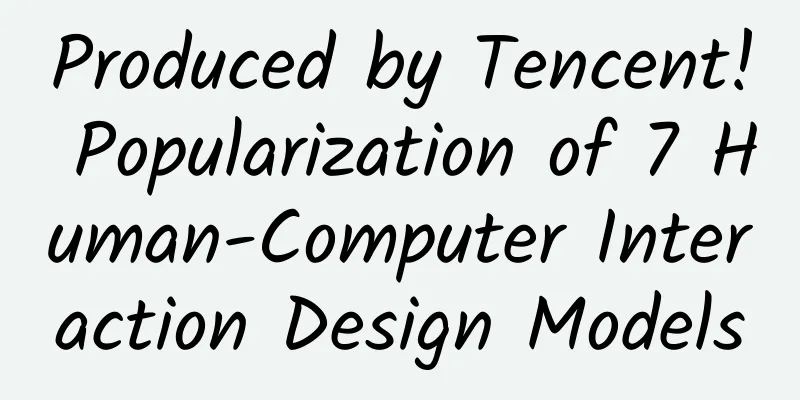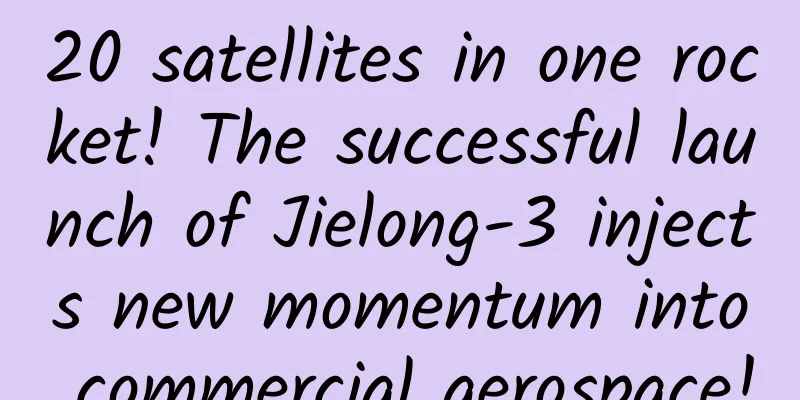Produced by Tencent! Popularization of 7 Human-Computer Interaction Design Models

|
As we all know, human-computer interaction is a discipline that integrates research, conception, design and testing. As a multidisciplinary discipline covering many fields, including but not limited to psychology, behavior, programming, engineering, design, research, and business administration, the core of modern human-computer interaction is no longer to solve problems from a technical level, but to focus on exploring the essence of problems from multiple perspectives and thinking about the value behind the problems. Therefore, the academic community of human-computer interaction has always tried to find a thinking mode or theoretical model to extract the complex thinking process. Mainstream interaction modelIn the past thirty years, the methodologies in the field of human-computer interaction have flourished. Although many well-known research institutions and universities have released different design models and flow charts, their core is roughly the same (finding problems - defining problems - designing - testing). The following are the seven most mainstream human-computer interaction design models in the world in recent years:
Among them, the first 6 should be relatively familiar to everyone, and we have also attached the official link at the end of the article for everyone to explore. In this article today, we will briefly take you to understand the last and most distinctive human-computer interaction model in the list: the Bridge Model (Analysis-Synthesis Bridge Model). Bridge Interaction ModelThe Bridge Model is a design flow chart (Analysis-Synthesis Bridge Model) published by the American Dubberly Design Office. For readers who are not familiar with it, the founder of this company, Hugh Dubberly, has published more than 50 research articles in the field of human-computer interaction, has been listed in many well-known design associations, and has been admitted to the SIGCHI Academy of the American ACM, becoming one of the people who have made the most outstanding contributions to the field of human-computer interaction. Dubberly has also worked in many well-known American universities. Therefore, this model is also a recognized theory in most international human-computer interaction disciplines. Although this flowchart is more abstract than other flowcharts, the multi-dimensional classification used in it explains the essence of design relatively clearly. As shown in the figure, the x-axis of the bridge model is divided into present and future, and the y-axis is divided into concrete and abstract, which are used to define the state of design. At the same time, the verbs "describe", "analyze", "research", and "make" are also added to define the operations in the design. In this bridge-type design process, the designer's process from the lower left corner to the lower right corner represents the process from phenomenon to abstraction and then from abstraction to product. At the same time, it also represents the process from today to tomorrow, or from the present state of the problem to the future state after the problem is solved. 1. Present tenseThe starting point is from the lower left corner, (what "is") represents the problem itself, and (model of what "is") in the upper left corner represents the abstract model of the problem or the essence of the problem. These two stages represent the research stage in design. At this time, the designer should "describe the concrete phenomenon" (Describe+Concrete in the lower left corner), that is, collect information to broaden the understanding of the problem, and then "analyze the abstract model" (Interpret+Abstract in the upper left corner) to create a problem model to see the essence and law of the phenomenon more clearly. At this stage, “the world didn’t know what kind of design he wanted” - Paola Antonelli The reason why we need to abstract the problem model at the beginning is that as a designer, we cannot simply listen to people's demands. When a problem occurs in life, people in life are often not clear about the essence of their troubles. Either they only see the surface of the problem, or they are confused by too many factors. Therefore, at this stage, the designer's responsibility is to analyze the environment and reasons for the existence of the problem, and to analyze people's real needs under the appearance from a human-centered perspective. Therefore, avoiding technology-centered analysis (machine-centered-research) and choosing human-centered research (human-centered-research) is the responsibility of interaction designers. When doing human-centered research, it is very important to avoid implicit bias when collecting and analyzing information. This refers to the unconscious bias that comes from growing up in a fixed society and culture, such as able-bodied people forgetting to consider the needs of people with disabilities, or people who often use electronic products subconsciously thinking that some complex operations are routine. In design, discrimination not only includes ignoring individual groups when collecting user information, but also includes the specific perspective of the designer himself. Although a successful design should meet the needs of most people, a good design should not ignore the situation of special groups. It must be mentioned here that although many designs nowadays often rely on big data for design, big data itself means ignoring the needs of a small number of groups, resulting in more serious discrimination against minority groups, and even threatening some niche topics. Therefore, considering race, age, economic situation, education level, disability and familiarity with technology during research can more rigorously analyze the impact of problems from different perspectives. Common user research methods in the lower left corner include contextual inquiry, stakeholder map, and participatory research, etc. Common analysis methods in the upper left corner include persona and journey mapping, etc. 2. Future StateThe two stages on the right represent the future state of the problem or the design prototype state (prototyping). The upper right corner (model of what "could be") represents the future possibilities of the problem, which is generally referred to as the design and conception part, while the lower right corner (what "could be") is to make these future possibilities come true, from concept to product. However, how do we go from the abstract model in the upper right corner to the specific design in the lower right corner? Here we need to understand a general design information hierarchy. As shown in the figure, a design is composed of multiple layers of structure, which can be divided into five stages from abstract to concrete: strategy, scope, structure, skeleton, and surface. A rigorous design should be developed from bottom to top (from deep strategy to shallow vision), and shallow interference should be avoided every time when considering deep strategy. This is because the shallow layer is only a way to express the strategy, while the deep strategy is the key to determine the core value of the product. When deciding the strategy, you should directly decide what product goals to set based on the "nature of the problem" in the upper left corner of the model. Only when the strategy is determined can the content and audience of the product be determined. If the goal is to allow blind people to order food, then the content may be to provide a special menu form and telephone shortcut keys on this page. If the goal is to let people listen to music, then the content may be to provide music recommendations and storage. In terms of structure, after establishing the content, only a perfect logic is needed, such as what is the specific user process, to quickly materialize the structure of the product. Finally, the framework and visual stage are more of a choice of expression method. Whatever design you ultimately choose, just make sure the framework and visual elements remain consistent throughout the product and fit the product’s positioning. The process from strategy to vision is the process from the upper right corner to the lower right corner in the model. The goal of every designer should be to realize a relatively abstract strategy with a concrete product. In order to closely link vision and strategy, it is necessary to consider whether the connection between the previous and next steps is logically smooth at each transition to avoid disconnection between layers. Although in reality, the separation between layers is often not so clear, this layered design logic can serve as a useful framework for designers to stay on target when they are thinking divergently. Even if the product is finally output in the lower right corner, a complete design process is not over. A successful design always requires multiple design iterations. Although the lower right corner may be the final output in each iteration, in a complete design process, the lower right corner should be connected to the lower left corner, and the completed design should be analyzed and tested again to summarize the advantages and disadvantages before the next round of design. The methods often used in the design part in the upper right corner include story boarding, paper prototyping, and human centered design. In summary, the bridge model, as the most commonly used model in international human-computer interaction schools, describes the process from research to solution from multiple perspectives. We can see that design is never a casual process. From the unbiased and systematic analysis of the problem on the left to the design following the structure on the right, designers should think and design within a rigorous framework so that they can solve problems in a targeted manner. Here, I also hope that everyone can pay more attention to various human-computer interaction design concepts and get inspiration from them or find a design process that suits them. Other design modelsHere are six other mainstream international human-computer interaction models and official links for you to explore: 1. Nielsen Norman Group Design ProcessResearch the problem area (discover), explore different possibilities (explore), test the design (test), and listen for feedback (listen) 2. Stanford Design Thinking ProcessEmpathize, define, ideate, prototype, and test. Official website link: https://web.stanford.edu/~mshanks/MichaelShanks/files/509554.pdf 3. Design Process in Contextual Design: Design for LifeUnderstand the problem (understand), invent the future (invent), design the scenario (design), prototype (validate), and develop the product (develop). Book link: https://www.goodreads.com/book/show/33805307-contextual-design 4. IBM Loop ModelObserve, reflect, and make. Official website link: https://www.ibm.com/design/thinking/page/framework/loop 5. Design Council Double Diamond ModelDiscover, define, develop, deliver. Official link: https://www.designcouncil.org.uk/news-opinion/what-framework-innovation-design-councils-evolved-double-diamond 6. LUMA Institute Design processlooking, understanding, making. Official website link: https://www.luma-institute.com/about-luma/luma-system/ ConclusionThe above is all the content of this article. I hope that after reading it, you can have a better understanding of the international mainstream human-computer interaction field or get some inspiration from it. Interested readers can also click the link in the introduction to go directly to the official website to get a more detailed introduction to the design concept. If there are any mainstream international design concepts not mentioned above, you are welcome to add and discuss in the comment section below~ |
<<: The truth lies in the details! 10 design details that effectively improve user experience
Recommend
"Kombucha", which has been popular both at home and abroad recently, can control oil, protect the intestines, and lower blood sugar?
gossip “Kombucha can protect the intestines, cont...
Information flow effect is not good? 80% of the time, there is a problem with the landing page!
Seeing the world through our eyes is an innate ab...
99% of traders have paid the price for these 5 pitfalls in live streaming sales!
Luo passed the baton of exceeding 200 million GMV...
Childhood Myth: Why do I forget to recognize a word after just looking at it for a while?
I think everyone had this experience when they we...
Review of 6 ways to play "crowdfunding fission": two keys to ensure you achieve explosive growth
Fission, a topic that has been talked about so mu...
DeepXplore: The first white-box framework for systematically testing real-world deep learning systems
By Yoav Hollander Compiled by Machine Heart Parti...
World Octopus Day | A lot of synonyms, eyes on the waist... The ancients' understanding of octopuses is really funny
October 8th is International Octopus Day. What? O...
Today is the first day of the Spring Festival travel rush! Please keep this travel protection guide
Today is the first day of the Spring Festival tra...
Working all year round and being tired is the right thing to do? He is the first one to disagree!
appendix: 1. Heart disease is a general term for ...
Where does the "poop" on planes, trains and ships go? Uncover the secrets of "travel poop"
Have you ever tried to go to the toilet at 120 ki...
Struggling in the mire: 6 routines I summarized for To B user operations
The Internet operations we often talk about are m...
Xiaohongshu is in a dilemma, and Mao Wenchao doesn't have much time left
1 E-commerce "hunting" Xiaohongshu A hi...
Alipay launches “Pay Later” feature: buy first and pay the next day
[[347332]] Recently, Alipay quietly launched the ...
Practical tips for operators and promoters: practical SEO optimization and promotion plans!
I believe that many friends who are new to SEO wi...
Do you feel that the channels are deceptive when promoting? See what the students in the channel say
As an operator who has worked in the mainstream i...









